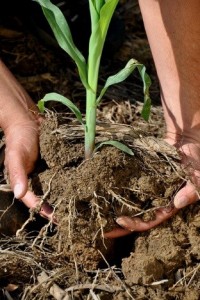This year, 2015, is the International Year of Soils (IYS). To celebrate IYS David Lindbo (@DavidLindbo), former president of the Soil Science Society of America (SSSA) and an IYS committee leader, explains why soils are vital to sustain every aspect of life (including plants of course!).
It’s the International Year of Soils! Tell this to someone and you’ll often get the response: “A year of dirt? Who came up with that idea?” So here is a blog post to answer exactly that and explain why soils are not just dirt.
Why soil?
Consider the world around you and all the things that make the earth a great place to live. We all require food, clothing, shelter, and water to survive – all of which are related to a single, often overlooked resource: SOIL.
Food
Consider your breakfast this morning: did you have cereal with milk, sausage and bacon, pastries, toast, orange juice? What were the ingredients? Flour from wheat, oranges from a tree, milk from a cow that has been fed on grass, meat from animals who are fed with grains and forage feed. All your breakfast foods, and foods in general, can be traced to plants, and plants are dependent on soil! Plants get water from the soil as well as the nutrients they need to grow. If we really think about it, when you eat, you are “eating soil”, several steps removed.
Shelter
Next, think about the home you live in. It is easy to see that bricks, made from clay and sand, are connected to soil. Lumber is wood, which comes from trees, which need soil to survive. So when you look at your house consider that it would not exist as you know it without the soil.
Clothes
Finally, consider the clothes you wear. Natural fibers used to make clothing are all directly related to plants – cotton and flax (linen) are plant fibers, wool is fiber made from the hair of animals that eat plants, and silk is made by silk worms that eat plants. Rayon is a semi-synthetic fiber made by processing naturally occurring cellulose, which comes from plants or trees. Even synthetic materials are derived from petroleum products made from fossil fuels, which in turn originate from plant and animal remains that have undergone extreme changes deep in the earth. They too needed soil when they were living. Once again we see that soil is critical to our clothing needs.
Water
Soil is critical to our food, fiber, and shelter needs. It also plays an important role in providing us with one other essential item: water. There is a finite amount of water on earth, and only a small proportion is drinkable. Given that it is constantly recycled, how does this water remain clean enough for us to drink?
In urban areas we treat water with chemicals to make it suitable for human consumption. However, many communities get their water from chemically untreated groundwater, which is treated by the soil instead. As water infiltrates and percolates through the soil, the chemical and physical properties of soil clean the water by removing contaminants. Soil is perhaps the largest single water (and wastewater) treatment plant in the world. Soil helps keep our drinking water clean by filtering it.

Healthy Soil for Healthy Plants. Photo by Natural Resource Conservation Service Soil Health Campaign used under Creative Commons 2.0
Happy soils mean happy plants
Soils are essential to plants and provide many of the nutrients they need to grow. In soils lacking adequate amounts of nutrients for crop production, we add some to ensure growth and a reliable food supply. These nutrients are then stored in the soil until the plant needs them. In this way soil acts as a nutrient reservoir for plant growth and survival.
Soil also provides critical support for the plant roots that anchor the plant to prevent it from falling down, being washed away or blown over. Soil also holds water in its pores. The water stored in the pores is removed by plant roots as needed for the plant to grow and photosynthesize.
To protect life we must protect soil
Soil connects us all. We need it to survive. As we move through 2015, the International Year of Soils, remember that if you know soil you know life, and with no soil there would be no life.
More information:
IYS is based around 12 monthly themes to reflect the diverse values of soils: information on these is available here. The SSSA also has a YouTube channel exploring the importance of soil, and a blog.





